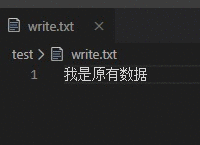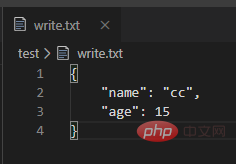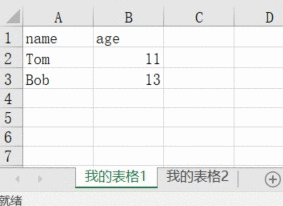

The front-end sometimes needs to process some data (such as the replacement of multi-language file content). We don’t want to do this kind of repetitive, boring and time-wasting work. ctrl C ctrl V's work, it is best to leave this kind of thing to the computer. [Related tutorial recommendations: nodejs video tutorial]
This article simply introduces how the front-end reads Excel or txt through Node The data in the file is then written to the txt method. First, give the content of the file: the test.txt file has only one sentence (I am the content of the txt file); in the test.xlsx file, the details are as shown in the figure:



Without further ado, show me your code:
/** 引入Node的文件模块 */
const fs = require("fs");
/** 获取要读取的文件的路径 */
const path = "./test.txt";
/** 判断该文件是否存在 */
const isExist = fs.existsSync(path);
/** 读取文件的内容 */
const data = isExist ? fs.readFileSync(path, "utf-8") : "";
/** 测试读取 */
console.log("test.txt的内容:", data) // test.txt的内容: 我是txt文件的内容/** 引入Node的文件模块 */
const fs = require("fs");
/** 测试Take you to use Node to read and write txt and Excel files */
fs.writeFile("write.txt", "测试Take you to use Node to read and write txt and Excel files", (err, data) => {
if (err) throw err;
}); Here we do not need to actively create write.txt, the code will automatically determine whether the file exists, and if it does not exist, it will automatically create the file. Note that if the file exists, when calling writeFile (refer to this for complete usage of this method), the original content will be replaced with new content. The operation is as follows:

There is also an append operation, which is to add data on the original basis:
/** 引入Node的文件模块 */
const fs = require("fs");
/** 测试Take you to use Node to read and write txt and Excel files */
fs.appendFile("write.txt", "测试Take you to use Node to read and write txt and Excel files", (err, data) => {
if (err) throw err;
});The operation is as follows:

Tips: What needs to be noted here is that when we write a JS object directly to the file, the result does not meet our expectations:
/** 引入Node的文件模块 */
const fs = require("fs");
const obj = {
name: 'cc',
age: 15
}
/** 测试Take you to use Node to read and write txt and Excel files */
fs.writeFile("write.txt", obj, (err, data) => {
if (err) throw err;
});Run result:

At this time, you can stringify the object through JSON.stringify(), that is:
/** 引入Node的文件模块 */
const fs = require("fs");
const obj = {
name: 'cc',
age: 15
}
/** 测试Take you to use Node to read and write txt and Excel files */
fs.writeFile("write.txt", JSON.stringify(obj), (err, data) => {
if (err) throw err;
});The results are as follows:

In order to make the writing format look better, you can add some parameters to the JSON.stringify() method ( For the use of JSON.stringify() method, please refer to this), for example, add a Tab indentation:
/** 引入Node的文件模块 */
const fs = require("fs");
const obj = {
name: 'cc',
age: 15
}
/** 测试Take you to use Node to read and write txt and Excel files */
fs.writeFile("write.txt", JSON.stringify(obj, null, '\t'), (err, data) => {
if (err) throw err;
});
/** 引入Node的文件模块 */
const fs = require("fs");
/** 引入Excel文件处理模块(若没安装,安装一下即可) */
const xlsx = require('node-xlsx');
/** 解析excel文档 */
const sheets = xlsx.parse('./test.xlsx');
console.log("sheets data:", sheets)You can see the output results:

The parsed contentsheets is an array, each A sheet takes the form of an object { name: 'xxx', data: [...]} as an element of the array.
The complete look is as follows:
/** sheets的完整内容 */
[{
name: 'Sheet1', /** sheet页名称 */
data: [
['name', 'age'], /** 第一个元素为表头 */
['Tom', 11],
['Bob', 13]
]
}, {
name: 'Sheet2', /** sheet页名称 */
data: [
['animal', 'legs'], /** 第一个元素为表头 */
['cat', 4],
['dog', 4],
['duck', 2]
]
}]From the above we know the format of the file after reading Excel , then writing only needs to be constructed according to this format, and then call the function to write~
/** 引入Node的文件模块 */
const fs = require("fs");
/** 引入Excel文件处理模块 */
const xlsx = require('node-xlsx');
/** 构建数据 */
const myData = [{
name: '我的表格1',
data: [
['name', 'age'],
['Tom', 11],
['Bob', 13]
]
}, {
name: '我的表格2',
data: [
['animal', 'legs'],
['cat', 4],
['dog', 4],
['duck', 2]
]
}]
/** 构建数据流 */
const buffer = xlsx.build(myData);
/** 将数据Take you to use Node to read and write txt and Excel fileswrite.xlsx */
fs.writeFile('./write.xlsx', buffer, err => {
if (err) {
throw err;
}
});Similarly, the write.xlsx file will be automatically created if it does not exist. The running results are as follows:

#At this point, we all know how to read and write files. Next, you can do whatever you want, and you can happily do it. Playing with data~
For more node-related knowledge, please visit: nodejs tutorial!
The above is the detailed content of Take you to use Node to read and write txt and Excel files. For more information, please follow other related articles on the PHP Chinese website!